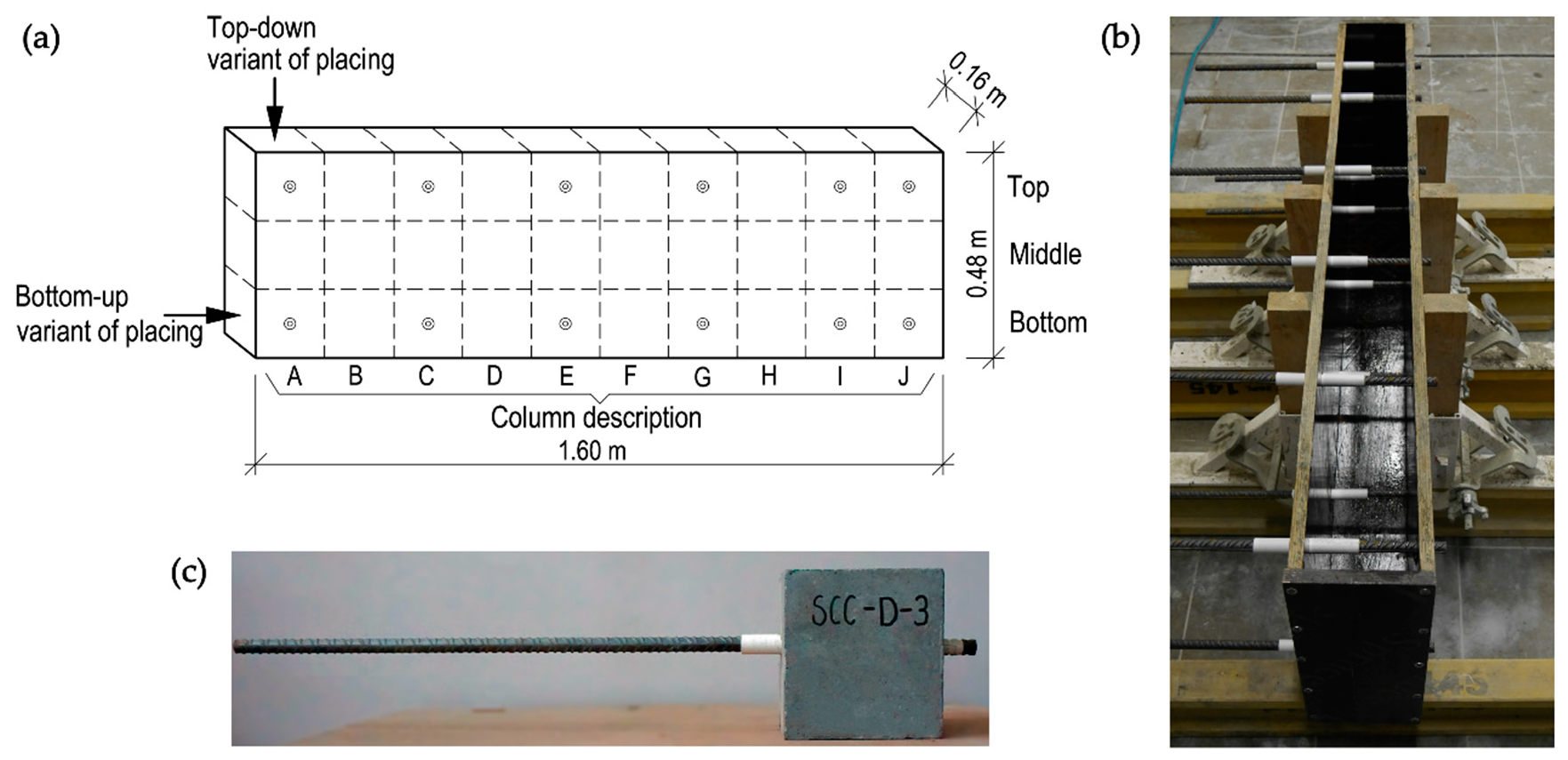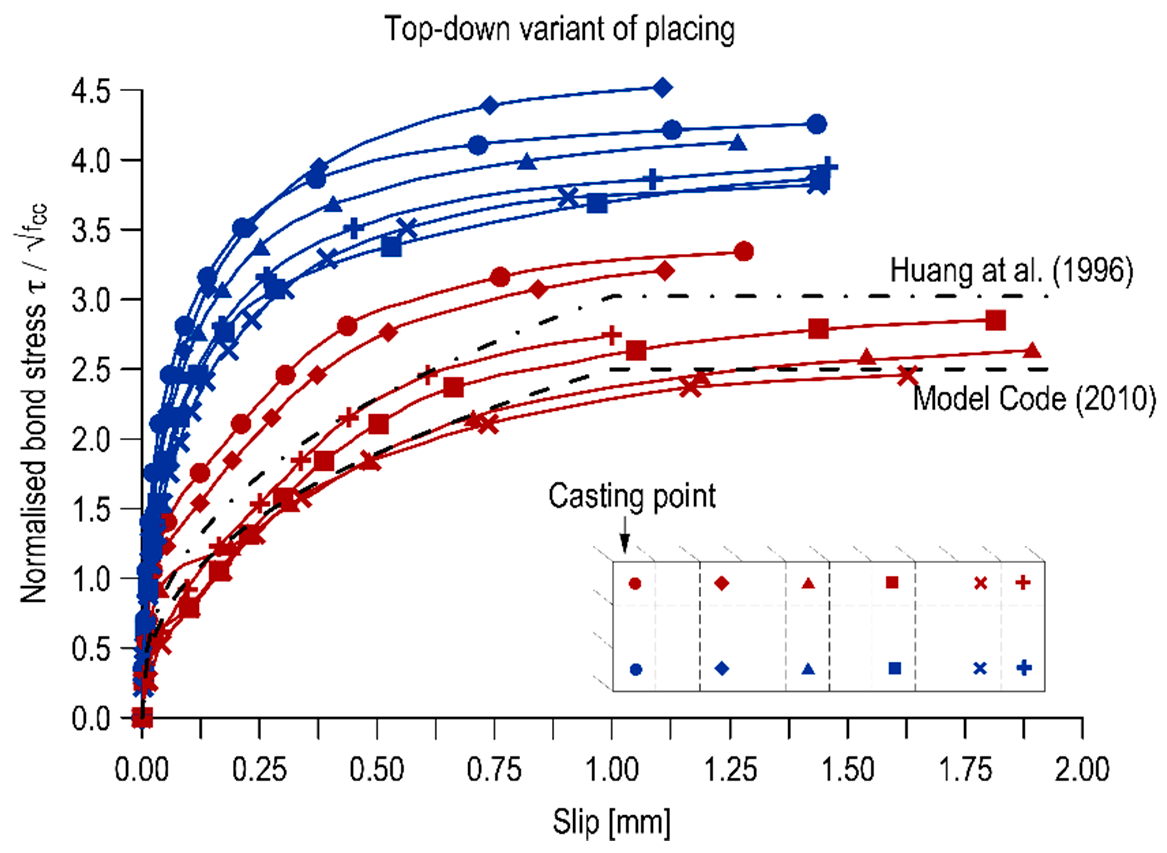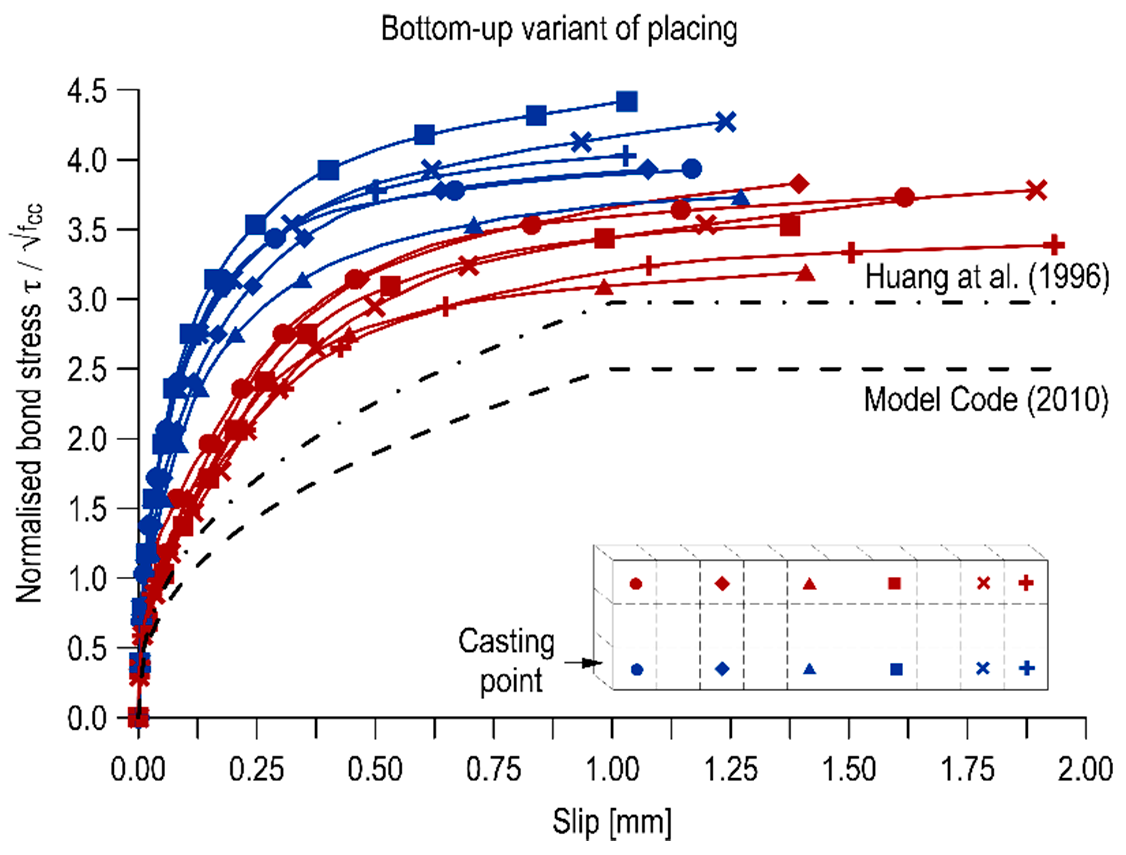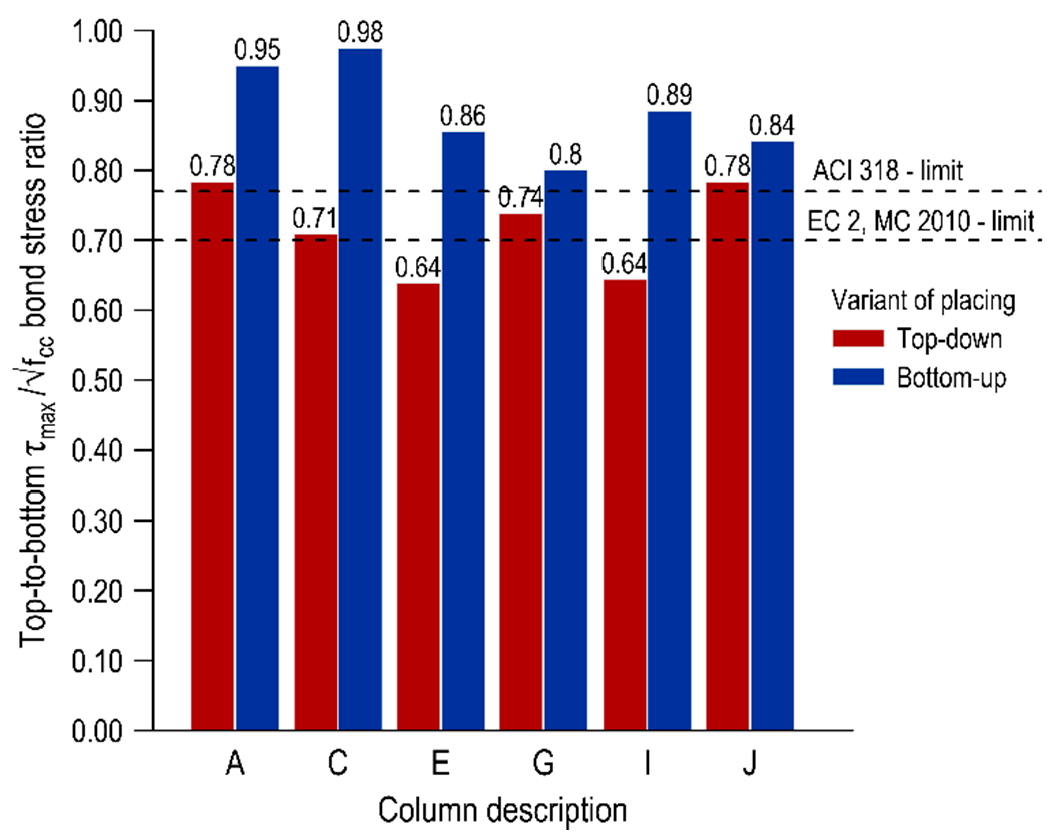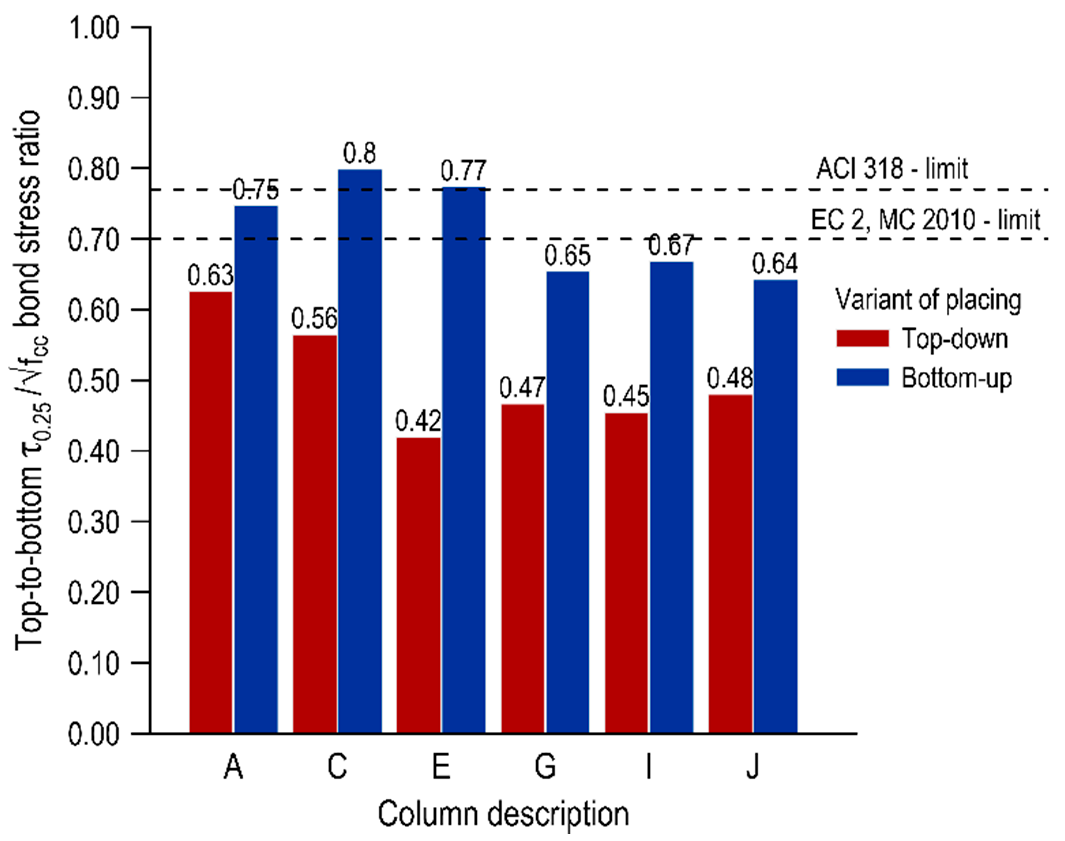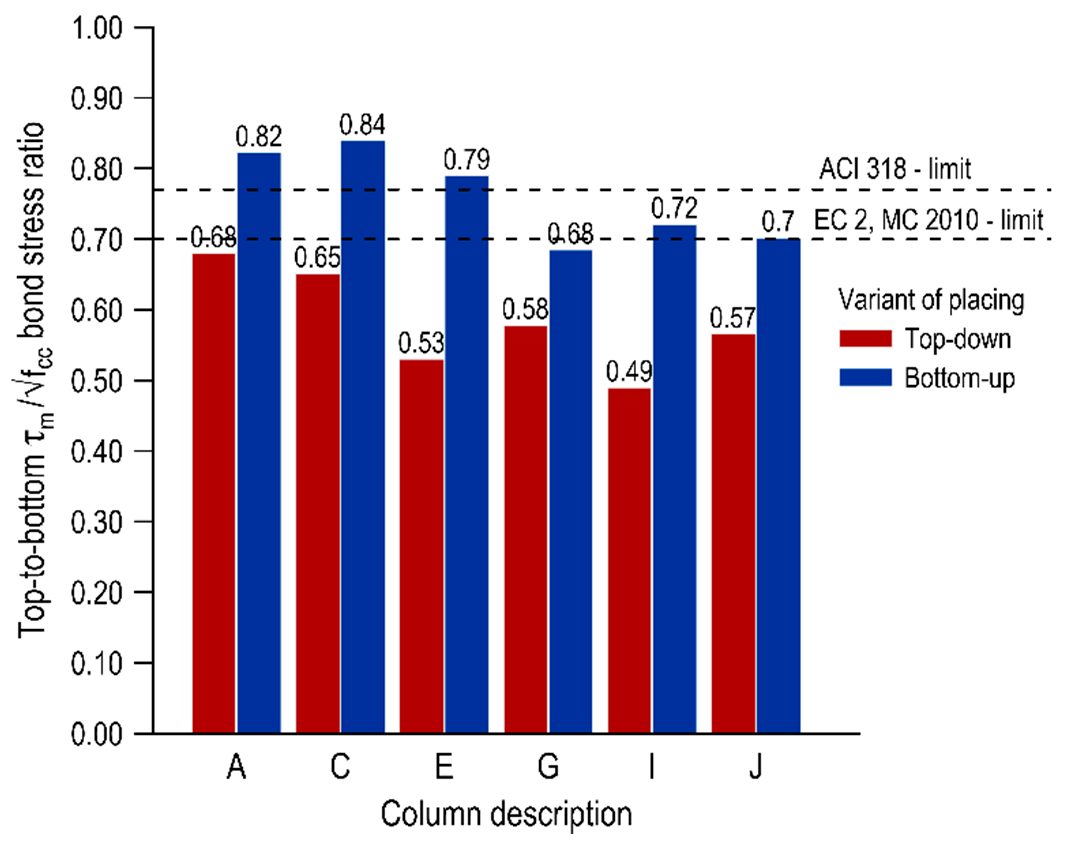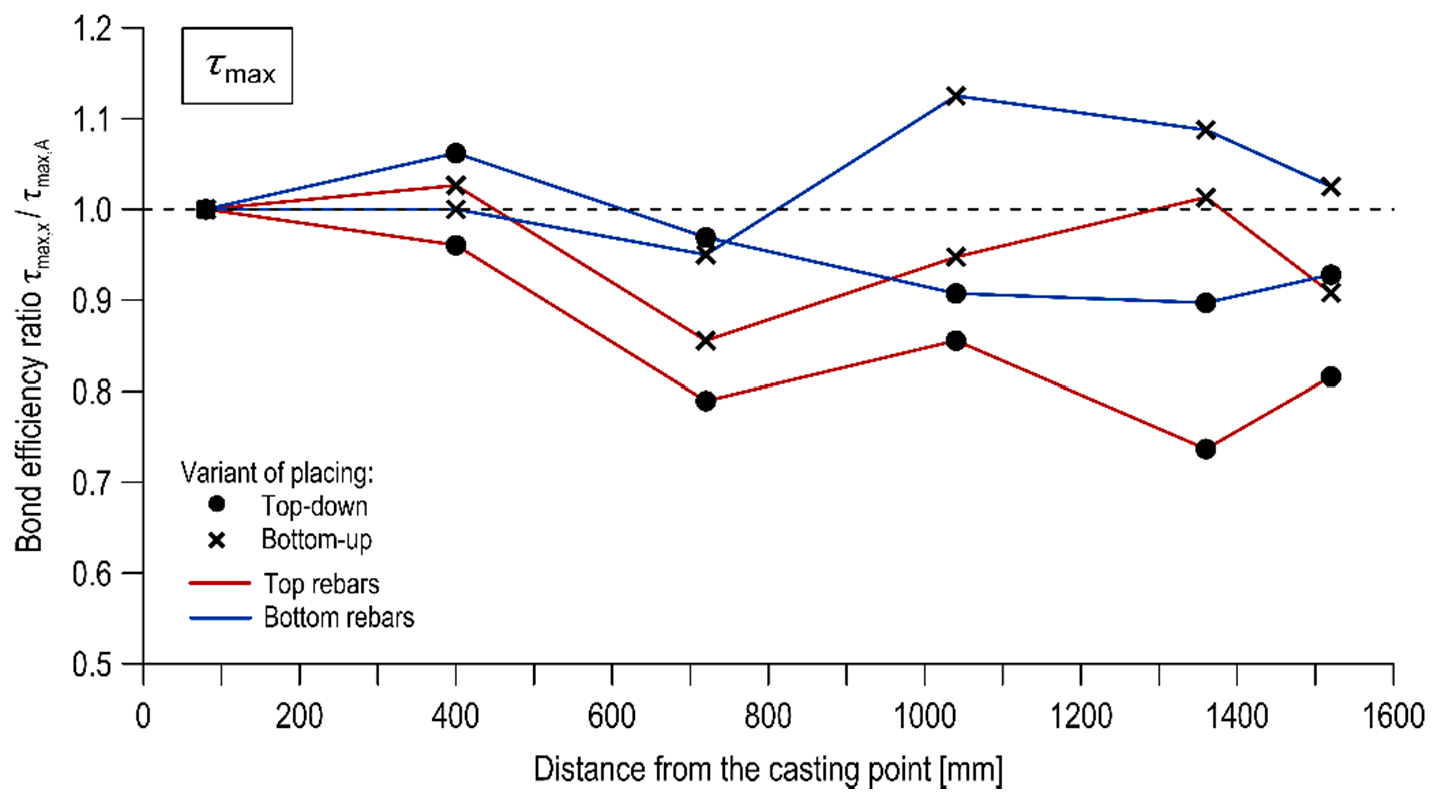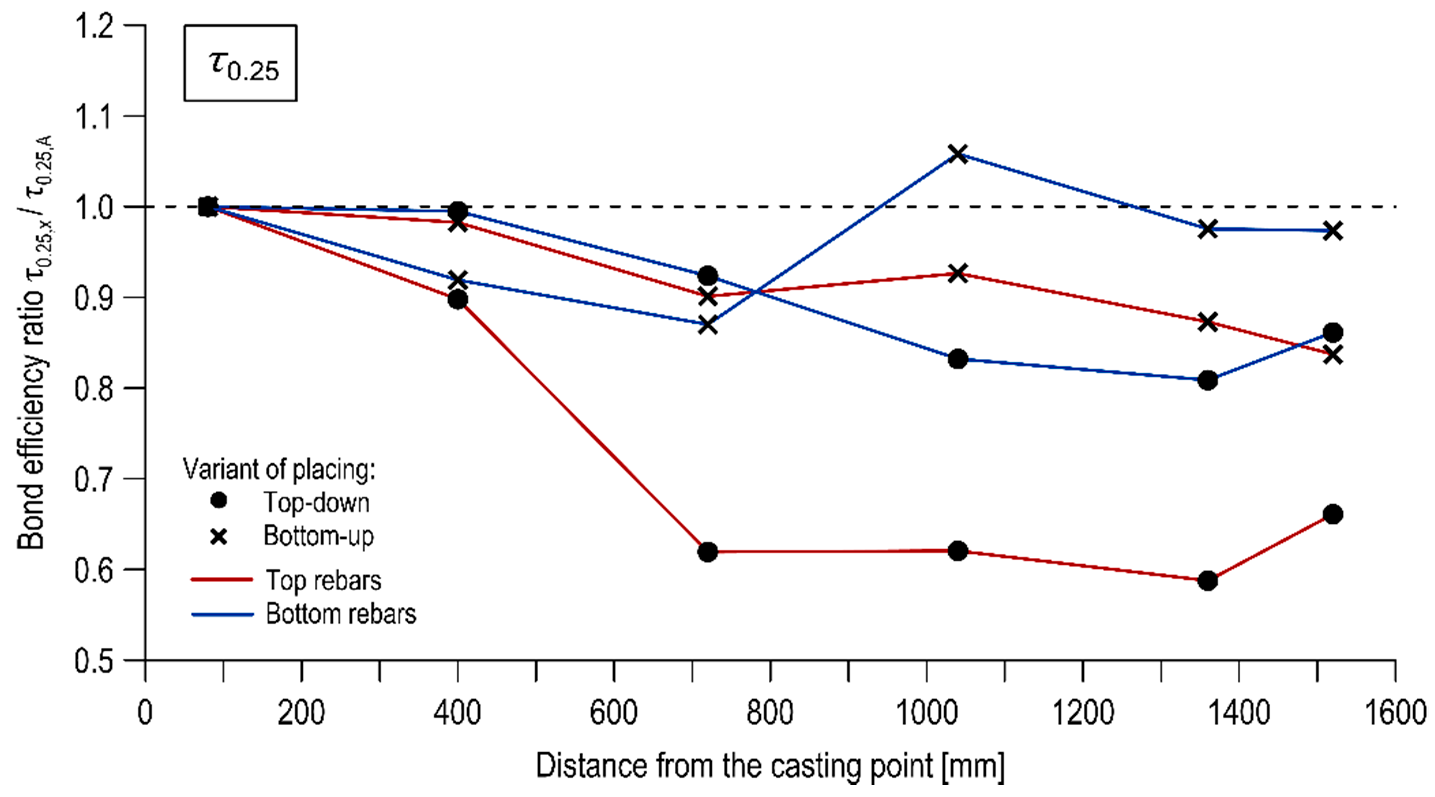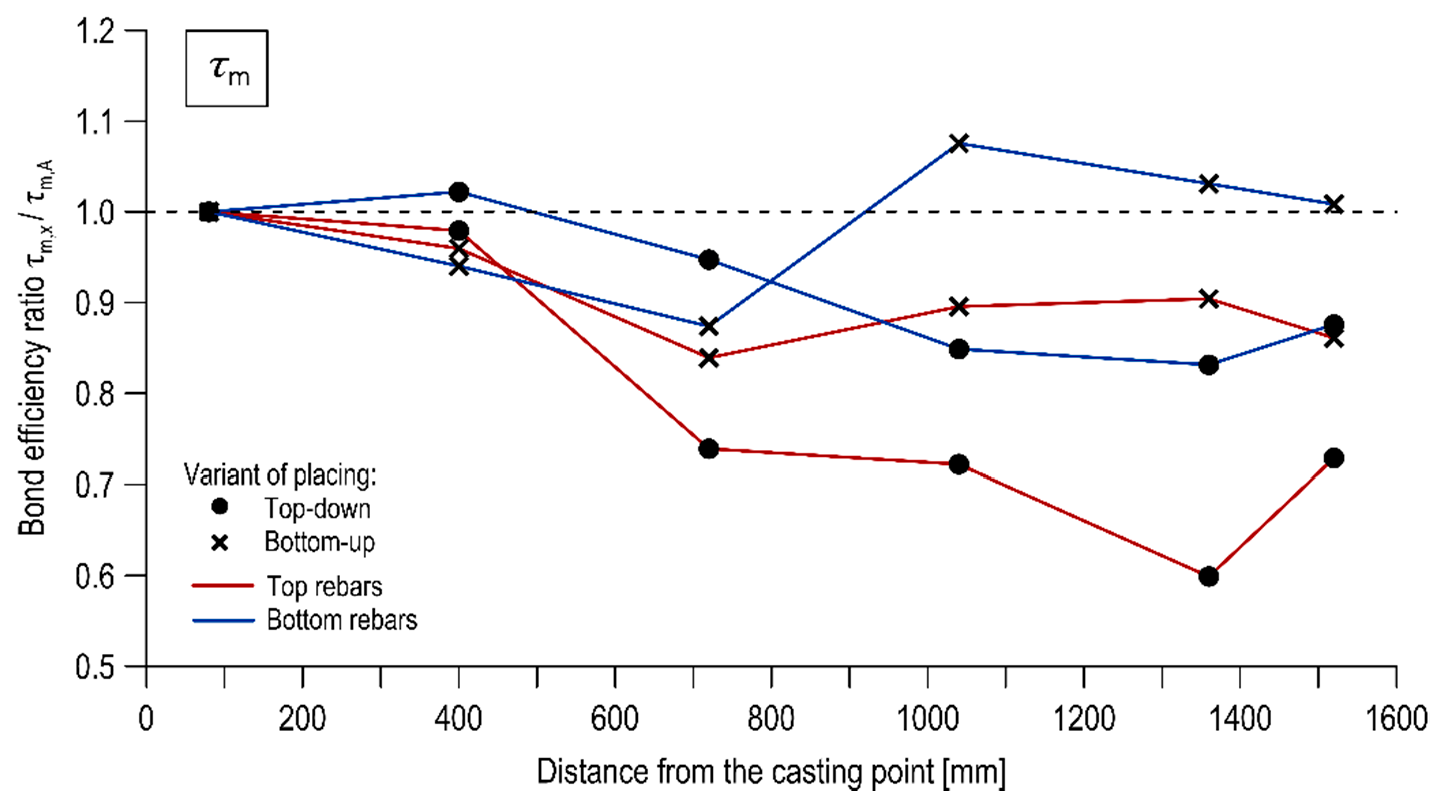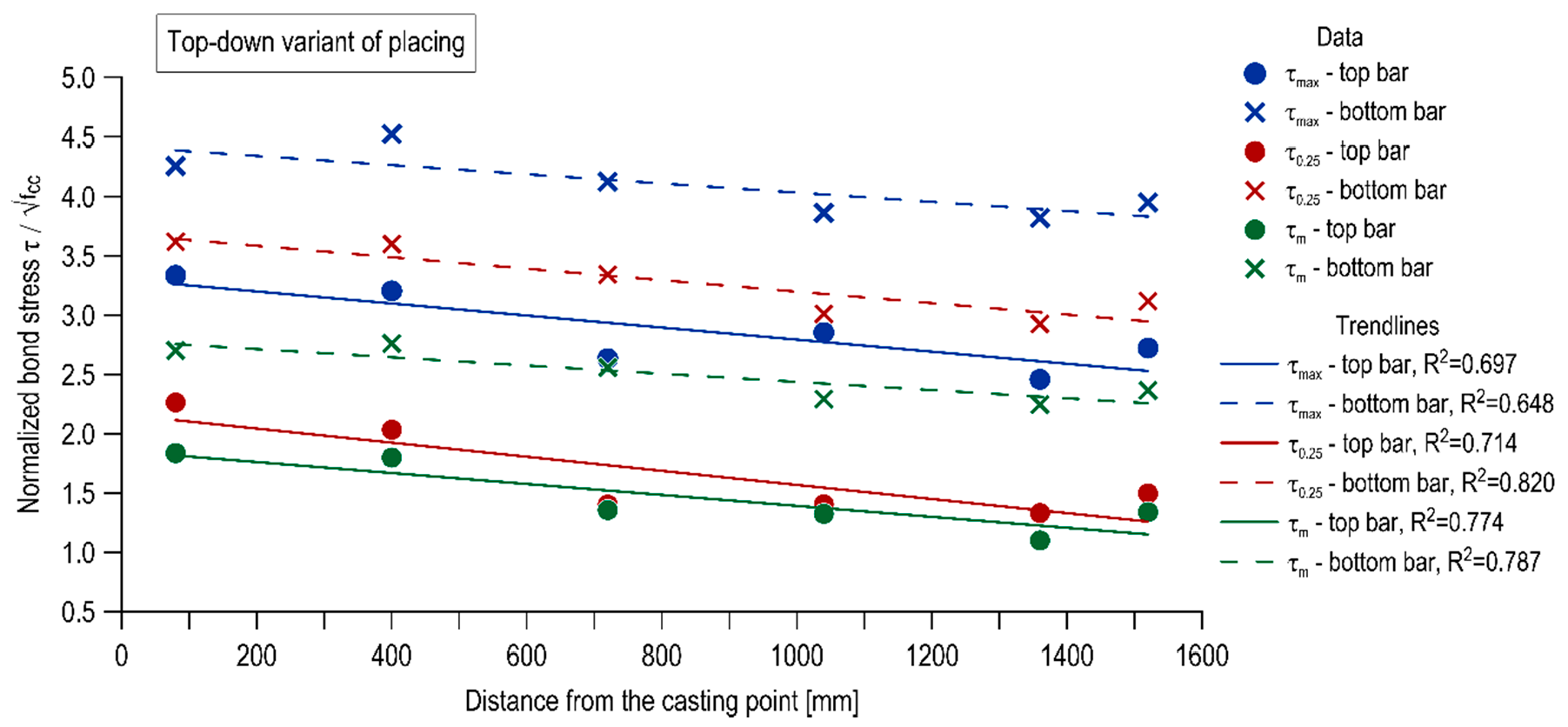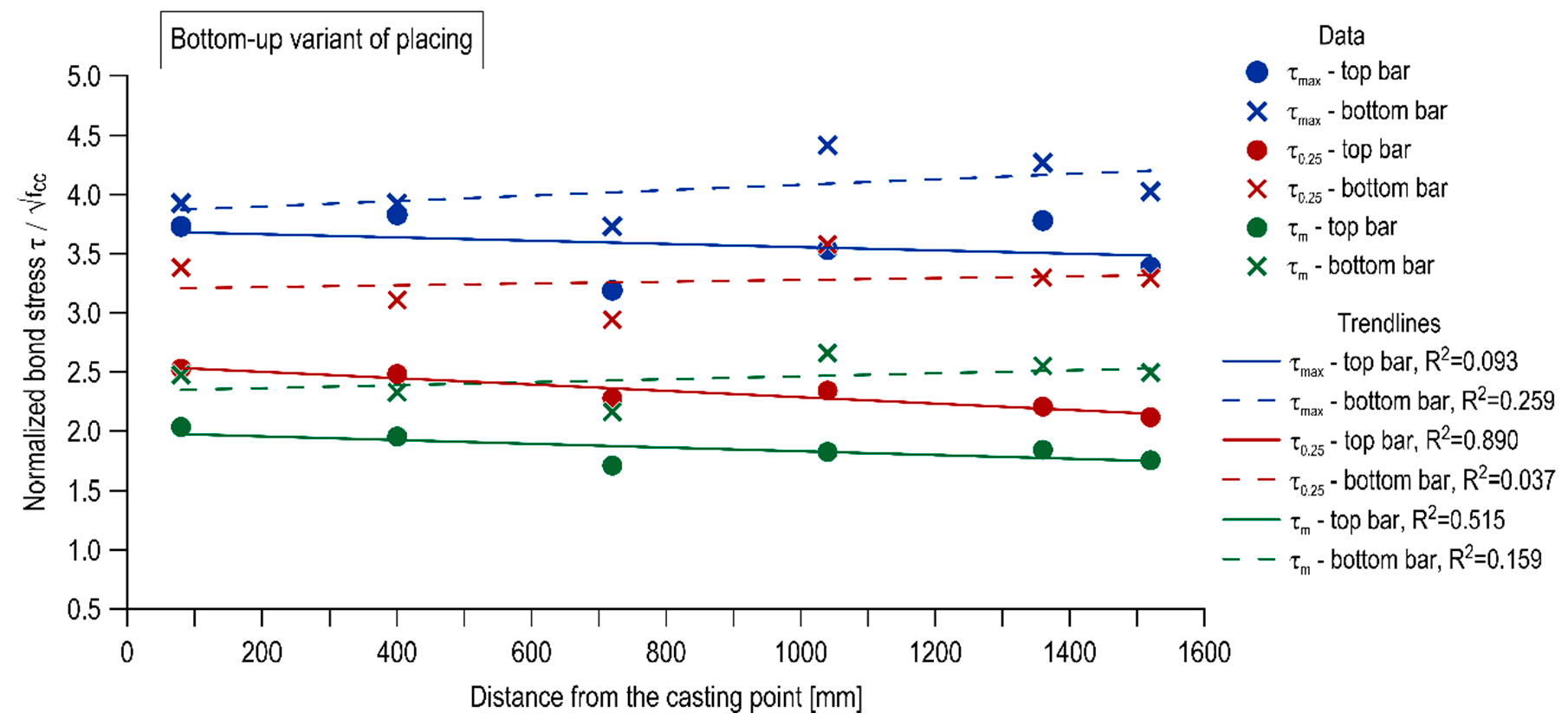1. Introduction
The unique rheological properties of self-compacting concrete (SCC) are widely known to provide a more effective way of placing it in the form. No additional mechanical compaction is needed as it is properly compacted (with lack of segregation) and vented only under its own weight even in the presence of dense reinforcement.
The application of self-compacting concretes in the construction industry brings a number of benefits throughout the entire life cycle of the structure in technological, economic, environmental and social terms. It is associated with the elimination of mechanical compaction, reduction of concrete surface trowelling, hence reduction of concreting and finishing time, material modifications of the mix (replacement of part of cement with mineral additives) and better mechanical characteristics of the hardened concrete. Furthermore, it is possible to manufacture the elements in different variants of concrete mix placing. First of all, it is possible to build an entire beam and wall elements from a single casting point. In the case of many points, it is necessary to adjust their quantity and location to the rheological properties of the SCC mix used, especially its viscosity (wall). Another technological innovation is the possibility of concreting both traditionally from the top (
Figure 1a) and the bottom of the form. A technologically appropriate and implemented variant of concreting from below is an injection of the mixture through an inlet connection in the formwork system with a shut-off valve (
Figure 1b). According to the general European guidelines for SCC concreting [
1], when placing the mix from the bottom, the pumping point should be as close as possible to the middle of the span of the wall, in order to reduce the flow distance.
The execution of elements from the bottom of the form is typically carried out by pumping the concrete mixture, and thus the literature [
2,
3] presents the advantages and disadvantages of this technology. The benefits of such an approach are primarily the more efficient self-deaeration of the mixture, and consequently the improved surface finish of the element. However, as the pumping is done through a specially prepared valve, there is a local deterioration of the surface finish around it. Additionally, this dedicated shut-off valve complicates the formwork and, therefore, increases its cost-efficiency. Nevertheless, given the fact that the bottom-up technology requires a slightly higher pumping speed with continuous work of the pump, the time of the element completion is shorter and the element itself is devoid of any discontinuities and weak interfaces. In general, the risk of mixture segregation is lower due to the continuous and uniform rise of the mixture in the form, which results in increased strength of concrete. However, in the case of elements with large spans, it is possible that dynamic segregation may occur due to the long flow distance. The main problem and hazard of this technology are the increased formwork pressure [
4,
5,
6]. Thus, it demands additional reinforcement of the formwork and complicates it.
One of the most important aspects of the bond phenomenon is the occurrence of deterioration in the bond conditions along the height of the element i.e., the ‘top bar effect’. This relates to a specific form of segregation that involves the movement of free water in the mixture towards the upper surface of the element, causing the top sections of weaker concrete of higher porosity [
7]. At the same time, the quality of the steel-concrete contact is lowered as a result of the settlement of the fresh concrete mixture below the rebar. The effect has been taken into consideration in the international standards [
8,
9,
10], and the decrease in bond strength is compensated for with an appropriate extension of the anchorage length. Despite a relatively comprehensive characterisation of this issue in the literature concerning SCC [
11,
12,
13,
14,
15,
16], in which many factors such as concrete strength, rheological properties of a mixture, length of the bond section etc. have been considered, so far no conclusive results have been obtained regarding the bond phenomenon in SCC. In general, the top bar effect is less significant in SCC concretes than in normal concretes, especially for smaller bar diameters and lower concrete strengths [
17,
18]. This trend is likely to be caused by the reduced vulnerability of SCC mixtures to bleeding which is associated with increased filler content and the low water-to-binder ratio [
19]. For instance, in a study conducted on 1500 mm high columns, [
12] made of normal and self-compacting concretes with a varying water-to-cement ratio, the reduction of ultimate bond stress for self-compacting concretes ranged between 32%–55% and from 60% to 74% for normal concretes. However, it has been noted [
20] that modification of self-compacting concrete with silica fume in an adequate amount—less than 10%—in relation to the cement mass practically eliminates bond reduction along the height.
The normative guidelines consider this effect via the extension of the anchorage length of rebars in ‘other than good’ bond conditions. However, only the top-down direction of the mix placing is taken into account. Moreover, the binding guidelines are based on the results of tests performed on normal concretes. In the American standard ACI 318 [
8], this is an enlargement by 30% of the anchorage length of horizontal rebars with a concrete layer of more than 300 mm underneath. Eurocode 2 [
10] is more restrictive in this regard and mentions an extension of the anchorage length of rebars by about 43% located in other than good bond conditions. Furthermore, longer anchorage lengths are required for the bars situated in sliding formworks, which are commonly used in contemporary structures, unless it could be indicated that they belong to an area of ‘good’ bond conditions.
The principal aim of this experimental study is to evaluate the effect of the bottom-up concreting direction on selected bond properties between steel reinforcement and self-compacting concrete. Hitherto, there have been no in-depth studies concerning this effect. However, the technological findings from the implementation on construction sites and laboratory tests (increased pressure on the formwork) and the recommendations for constructing concrete elements in this technology are included in international standards and scientific papers [
1,
2,
21,
22,
23,
24,
25]. It is observed that there is a growing interest in this technology within the construction industry, so it would seem appropriate to investigate the effect and its impact on the parameters of the hardened concrete, including its bond to reinforcing bars. Authors have already started working on the project concerning high-perfomance self-compacting concrete (HPSCC) [
26]. The authors found that the casting direction has an influence on the phenomenon of the steel–concrete bond in the case of both HPSCC mixtures containing a filler in the form of silica fume and those based entirely on cement. A significant positive impact of bottom-up placing on the uniformity of bond conditions across the height of the elements was identified. The promising results of those studies are encouraging for more comprehensive research. The paper intends to continue the research and observe the phenomenon for self-compacting concrete of normal strength with a filler in the form of fly ash, which is the most commonly used type of SCC in concrete constructions.
2. Materials and Methods
2.1. Materials
For research purposes, one concrete mix was adopted, the composition of which is presented in
Table 1. The mix is based on Portland fly ash cement (CEM II/B-V 32.5R) and fly ash (FA) as a mineral additive. The investigations assumed development of a self-compacting mixture of possibly low strength. The recipe was developed based on common literature and previous experience of the authors.
The investigations were performed on elements with embedded deformed reinforcing bars of 16 mm diameter that were made with reinforcing steel of B500SP class. The rebars met the requirements of EN 10080 [
27]. The mean values of the mechanical parameters of the rebars are given in
Table 2.
2.2. Test Specimens and Basic Modules
For the purpose of this research, elements with dimensions of 160 × 1600 × 480 mm, in which ribbed reinforcing bars were embedded, were made. The element was designed to be divided into cubes of 160 mm side. This is the primary dimension for the basic module for pull-out bond tests involving bars of 16 mm diameter. The dimensions of the basic module—10d × 10d × 10d—were recommended in RILEM TC [
28] and EN 10080 [
27]. In each basic module, the ribbed reinforcing bar was embedded centrally. The specimens were designed to consist of 12 basic modules for bond tests, the remaining cubes were tested for compressive strength. The reinforcing bars were embedded along the height and length of the element to maintain their perpendicular position to the direction of concreting (
Figure 2). For the analysis, the beam was virtually divided into columns marked with the letters A to J starting. A single casting point was established at one edge of the element and was within the area of column A.
The elements were made in two variants of concrete mix placing—traditionally from the top of the form (top-down) and from the bottom (bottom-up). The approach of bottom-up placing of concrete was executed by a specially prepared piping routed above the upper level of the form. Following the principle of connected vessels, the concrete mixture filled the form from below under own weight, initially flowing along the span of the element. When the base is fully covered to the level of the inlet, by lifting the upper poured layer, the mixture spreads evenly along the span. A discharge rate through a funnel was estimated as 0.5 L/s.
The formwork was stripped after 3 days of concrete curing. The specimens were left in a constant position at laboratory conditions for the entire period of the concrete curing cycle. The concrete was maintained by water sprinkling during this period. The specimens were cut into elementary parts after 21 days, and after 28 days compressive strength and pull-out tests were performed.
2.3. Test Procedures
2.3.1. Fresh Mix Properties Tests
Fresh self-compacting mixes were tested in order to evaluate rheological properties as well as air content. The rheological behaviour of the fresh SCC was identified during three tests. A slump flow test that was conducted served as an investigation of both flowability and plastic viscosity [
29]. The measured parameters are the final slump flow diameter and the time T
500 which is related to slump flow time up to a diameter of 500 mm. The passing ability was tested during the L-box test [
30]. This property is deduced from the L-box ratio. Finally, the fresh visual segregation index assessed after conducting a slump flow test allowed the segregation resistance to be determined [
31]. The rheological tests were performed immediately after the completion of mixing.
Moreover, the percentage content of air bubbles in the mixes was tested with a pressure gauge according to EN 12350-7 [
32]. The test was conducted after a temporary stabilization of a mixture in a normative container.
2.3.2. Compressive Tests
The compressive strength was investigated according to EN 12390-3:2009 [
33] using cubic elements derived from the test element that was not adopted for the bond test (
Figure 2). As the dimensions of the samples were 160 × 160 × 160 mm, it made them designated sizes [
34] of samples. It allowed on verify the changes of the compressive strength over the heights and across the lengths of the specimens. Moreover, cubic elements of nominal sizes 150 × 150 × 150 mm were cast from each batch and tested on compressive strength. Overall, 46 cubes were tested in terms of compressive strength.
2.3.3. Bond Strength Tests
There are several different methods of testing a steel-concrete bond. In this research, the pull-out method was adopted. The approach meets the requirements and recommendations of RILEM TC [
28] and EN 10080 [
27] and is conducted on cubic samples. It is a fundamental method for the assessment of the reinforcing bars–concrete interaction depending on concrete properties or type of reinforcing bars. The method assumption involves the application of a tensile load to the bar anchored in a concrete block. The measured data refers to the load applied to the bar and the relative displacement between steel and concrete.
The main advantage of the method is an assumption of linear deformation along the rebar length; thus the bond stress (τ) is presumed to be constant and could be calculated using Equation (1):
where
F,
d and
l stand for, respectively, the applied load, reinforcing bar diameter and bond section length. The bond length—
l—was experimentally adopted as 3.75d. With a greater bond length (the normative value is 5d) the bond forces would be so high that the reinforcing steel would yield and a pull–out failure would not occur. The bond section length was provided by plastic tubes put over the remaining part of the bar.
The pull-out test was performed on 24 basic modules overall. The pull-out load was applied progressively up to the bond failure point. The measurement of the slip of the unloaded end of the rebar was taken using two linear variable displacement transducers (LVDT). A data acquisition system was used.
2.4. Result Analysis Procedures
This work analyses three representative bond stresses—the ultimate bond stress (τmax) and the critical bond stress (τ0.25) and the mean bond stress (τm). For this purpose five bond stresses were retained from each bond-slip curve: τ0.01, τ0.10, τ0.25 and τ1.00, in respect to slips s = 0.01 mm, 0.10 mm, 0.25 mm and 1.00 mm, as well as τmax, at the time of the bond failure.
The value of the ultimate bond stress τ
max, which is also known as the bond strength, is proposed in numerous studies [
11,
12,
13,
35] given its clear and unambiguous definition. The bond strength corresponds to the bond stress reached at the time of the bond failure. The second representative value found in the literature [
36,
37] is the critical bond stress corresponding to a slip of the rebar, 0.25 mm, τ
0.25. As the value of the slip considered in this case (0.25 mm) is always lower than the one obtained when reaching the ultimate bond stress, the value of the critical bond is considered as more conservative and more secure in design than τ
max. The final value considered here is τ
m, which is also widely used in the literature [
12,
35] and is recommended by RILEM TC [
28]. It is calculated from Equation (2) as the arithmetic mean of the bond stresses τ
0.01, τ
0.10 and τ
1.00 corresponding to the slips of 0.01, 0.10 and 1.00 mm, respectively.
To exclude the effect of the concrete compressive strength on its bond to reinforcement, the normalization of the representative bond stresses to the square root of the corresponding cube compressive strength of each batch (τ/fcc0.5) was introduced.

